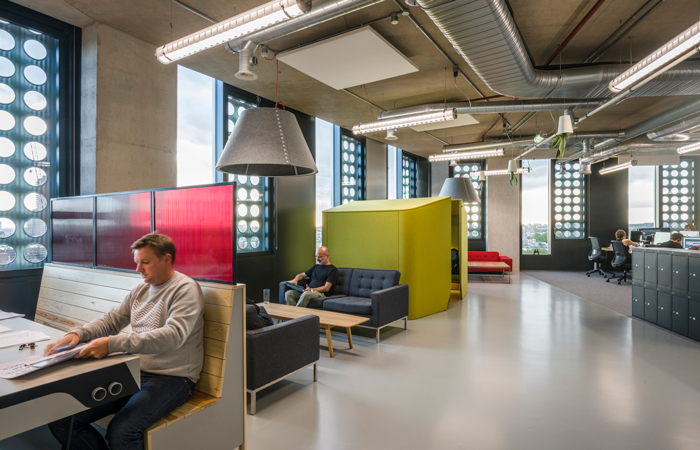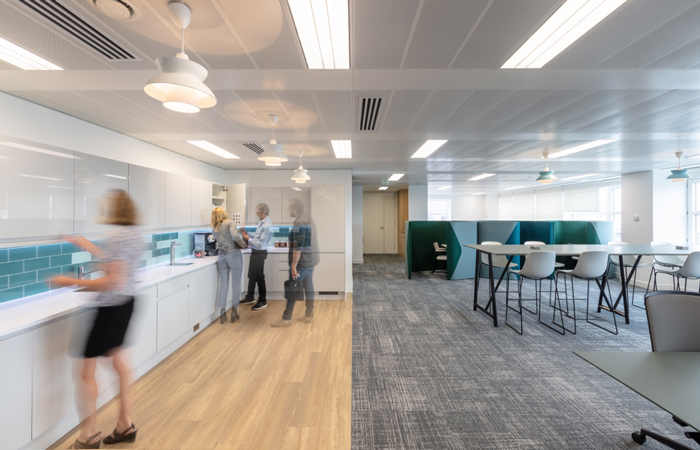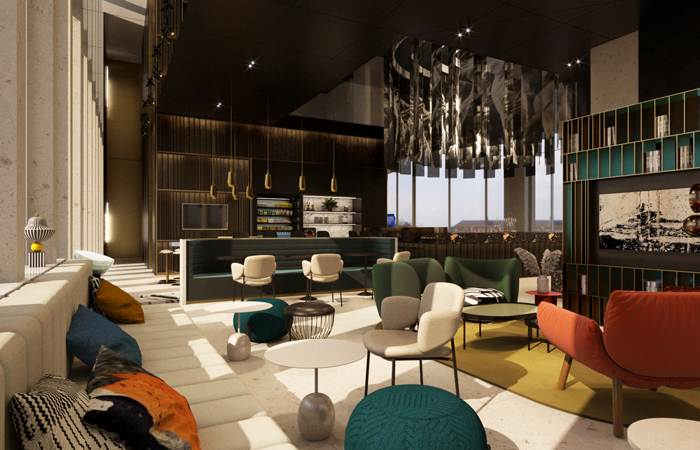WFHotel – HIX EVENT CONVERSATION
Following on with our subjects for discussion we look at the seminar, entitled “WFHotel”
“The world once travelled to an office from nine to five, sometimes visiting a hotel for a business lunch or to grab a quiet spot to work from. And one day it all stopped, everyone stayed inside. Home became the new office, the new hotel and through creativity, optimism and technology people adapted, they kept on working. Now, as the world re-opens something’s changed forever and will never go back to what it was. A brave new world can be designed.”

We asked John Williams, Founder, SpaceInvader, Gurvinder Khurana, Director, align and Chris Gwyther, Founder, Phoenix Wharf for their thoughts on the hotel as our new productive, fluid and well workplace.
In what ways has the workplace been impacted by the pandemic?

Hotels need to offer hard and soft furniture for the work and hospitality mix, as in this workplace scheme by align for Spark44.
John Williams (JW): The number one change generated by the pandemic was of course enforced working-from-home and the number one lesson was what could and couldn’t be achieved within that paradigm. Mostly, in fact, people coped in the short term vastly better than anyone expected, although younger, less family-orientated people missed the social and mentoring aspects more on the whole and also tended to have less space at home to set up a successful home office. The immediate impact now we’re returning to the office has been the tendency for a hybrid set-up with individual companies working on very different office-WFH splits.
Gurvinder Khurana (GK): Where we work has been impacted hugely, with myriad ramifications for the future, but the impact has been just as great on the ‘how’ of our working lives. The future impact of that will be long-lasting and possibly in ways we can’t yet see. The principal attitude reboots brought about by the pandemic have been a new emphasis on performance over presenteeism, an increased value placed on the work-life balance and a further boost to our health-consciousness, both physical and mental.
Chris Gwyther (CG): The workplace has shifted from a purely physical working environment to a hybrid future. As a result – and mirroring the retail sector – businesses are reassessing their ‘physical portfolio’, which is no longer fit for purpose. Many companies will find they have an excess of space as staff return to the office part-time and will find a change too in who the office needs to appeal to – workspaces designed around the commercial and operational needs of senior staff, with the needs of general employees previously considered to have less significance, will need to work harder to attract ‘general employees’ back. Additionally, the pandemic has coincided with a growing environmental consciousness, where the impact of the daily commute is being questioned as never before.
Will the use of office space change as we come out of the pandemic?

Workspace furniture and surfaces vary according to the task as here in this scheme for Eden McCallum by align.
JW: The knock-on effect is that the office can no longer be considered the established location for focused work but is instead a place people come together for the social and collaborative aspects of work and also to create culture – a vital aspect of a successful business that gives a business its identity and its people their sense of belonging.
GK: Yes, most definitely. People have missed the office not just for collaborative work, but for friendship too. Some of our younger team members elected to come back full-time as soon as they could because they missed the camaraderie – and, like many young workers, they don’t have great set-ups at home to work from. Personally, I’m not convinced the huge reductions in floorspace some are hoping for will happen. There will definitely be an increased focus on community spaces, but adjacent support spaces will still be necessary. When we come out of meetings, we often want to do a ‘brain dump’ whilst thoughts and ideas are still fresh – not after returning home hours later. Truly agile spaces mean both are present in flexible amounts. Time allocation will become as important as space allocation. Leaders need to organise their time with open-door ‘anchor days’ in the office and a reduction in back-to-back meetings.
CG: Yes. We are at the start of a long-term shift in the way people work and in the role of the traditional workspace. The office will need to facilitate anything that can’t effectively be undertaken by an employee at home and become a space for interaction and ideation above all, providing the humanistic and social interactions inevitably impossible in a home-working environment.
What impact could this have on the additional spaces people choose to work in?

Visual of a lounge space for guests and co-workers in current SpaceInvader.
CG: Working from home has been understood by many to be a perk, involving reduced commuting time and cost, as well as the practical advantages of being able to be at home to work more flexibly around family demands, to take in parcels or have the boiler serviced! The attractions of non-home / non-office spaces will revolve mostly around location and convenience, but also the appeal of great aesthetics and functionality, whether that’s spatial or technological.
JW: It means additional spaces are more relevant and necessary. The recognition by businesses that remote working is perfectly possible means the non-office location can actually be anywhere, an especially-useful scenario for people travelling to get to meetings and finding themselves between a meeting and a train time, for example, and needing a transient and effective place to plug in and work.
GK: I think the future will be less about the office + WFH, but the office + WFA – work from anywhere. The customer/worker/visitor is king. Let’s see who steps up to offer us the best environment for those times when we’re not office-based!
What role could hotels play in the future of the workplace?
JW: First of all, to recognise the need for working-on-the-move which I’m sure most good hotels do now, and to make sure they’re responsive, receptive and welcoming to people wanting to work through offering easily-accessible spaces, dawn-to-dusk service and realistic F&B pricing.
GK: For anyone commuting regularly into a major conurbation, hotel lobbies and bars have been a useful place to conduct certain business meetings for a long time now, offering location-convenience and a degree of privacy too. With hotels adapting more for the co-working market, this usage is likely to grow, especially for people looking for short-term spaces between meetings.
CG: Hotels could adopt a hybrid approach to providing workspace, offering a greater mix of facilities including both business support and leisure activities. These should particularly appeal in more regional and localised locations, where workers will be looking for satellite office space in order to avoid going into large city centres. If people are offered a deal on co-working space with good tech, hospitality-on-demand and the possibility of using a gym or pool, that becomes a very attractive proposition.
What will be the design requirements of these spaces?
CG: First of all, the mindset of being enablers of remote working and, from that, becoming wider collaborative and social hubs offering work and leisure-related facilities. Hotels should exploit their typically large footprint to provide great-looking meeting rooms, conferencing facilities, high speed internet connection, hot desking and hospitality services, with easy transition between getting a coffee whilst working and entertaining a guest over lunch.
JW: Large meeting rooms will be a major requirement. As companies take smaller office spaces to accommodate the hybrid model, it will be harder to collaborate at volume and harder too to deal with meeting room spikes, so as well as lounge areas for individual workers in transit, larger rooms – especially with good tech requirements in terms of AV and acoustics – will be a major asset. In terms of look and feel, let’s not forget workspace design has been moving towards the hospitality sector for quite some time now, with incorporated F&B, a variety of zoned seating arrangements, higher-spec comfortable furniture, more textured materials and integrated artwork. As long as price points stay realistic, hotels will continue to be an attractive option.
GK: The biggest design shift will need to be in infrastructure – specifically in terms of technology. If you can’t plug-and-play or get speedy F&B service, the game will be up. People on the move also need charge point totems and the UK is currently way behind on this compared to mainland Europe. The other interesting design requirement will be to do with furniture and the inversion of the current workspace trend, where there are increasing levels of hospitality-style FF&E. The furniture mix in hotels needs to become more varied and suited to work needs. No one wants to sink into a deep armchair and try to type on a tiny, low coffee table.
Contact SpaceInvader Design
Contact align
Contact Phoenix Wharf
The BCFA are a co-founding partner of Hotel Interiors Experience – HIX





Comments